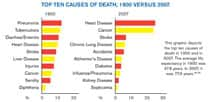Life Extension Magazine®
| In the 20th century alone, smallpox killed 300 million humans worldwide.1,2 Historically, the disease infected so many people that no one thought it would ever go away.
While the smallpox virus was ravaging Europe, certain Asian populations had discovered a crude but effective method to prevent the infection. It was realized back then that those who survived smallpox were immune for life. Asians began taking pus from infected people’s scabs and rubbing a small amount into a cut made in a healthy person’s arm (or blowing dried powder from smallpox scabs up healthy people’s noses).1,3 It took Europeans about 700 years to adopt this practice. While 2-3% of people exposed to this procedure died of smallpox, the practice decreased overall smallpox fatalities 10-fold.4,5 Edward Jenner demonstrated in 1796 that inoculation using fluid from cowpox lesions could safely prevent smallpox.5,6 Jenner’s research was initially rejected, but by 1840 the British government provided Jenner’s vaccination free of charge. Jenner coined the term “vaccine,” and widespread use of improved versions resulted in smallpox being the first human disease eradicated by vaccination.5 What’s interesting is that no one back in those olden days had any idea that viruses existed, yet enlightened individuals were nonetheless able to take steps to reduce their risk of contracting smallpox. Smallpox Brought Down EmpiresThe smallpox virus is believed to have appeared around 10,000 BC. It originated in Africa and spread to India and China. It took many more centuries to reach Europe. The impact of smallpox on major historical events, such as the rise and fall of empires, is largely forgotten.
For example, the Europeans were able to quickly conquer much of the Western hemisphere because while they carried smallpox, many were immune to it. Native Americans had never encountered the virus, and their populations were completely vulnerable. Not only did smallpox kill more than one third of Native Americans, but powerful empires such as the Aztecs were persuaded to convert to Christianity because they interpreted the smallpox epidemic that ravaged them as a sign their gods were weaker than the Spaniards.1 Had Native Americans been the ones harboring infectious diseases as insidious as smallpox, it is unlikely that Europeans would have so readily prevailed in conquering the Western hemisphere. One reason Napoleon sold the Louisiana Territory so cheaply to the United States is that a large contingent of his army was wiped out by yellow fever (a mosquito-borne virus) in Haiti and he feared losing an entire war if French soldiers died of these kinds of plagues in the New World.7 What Does Smallpox Have to Do With Aging?Aging is having an impact on today’s empires similar to smallpox centuries ago. By year 2020, more than half of all federal revenue collected in the United States will go to support the aging population. As one can see from the chart on this page, when interest on the national debt and Medicare is factored in, there will be virtually nothing left to pay for other federal programs. Medicaid spends huge dollars caring for aging people who can’t afford healthcare costs not paid by Medicare, or those who have no Medicare coverage. Medicaid not only drains federal resources, but is also driving state governments towards insolvency. Japan and many European countries suffer the same situation, as the percentage of the aging populations outstrips the number of younger workers that can support them.8,9 Just as smallpox dramatically altered the course of human history, so will aging devastate the modern industrialized world unless something is done to gain control over it. We Know More About Aging Than Previous Generations Did About Smallpox
For nearly 12,000 years, mankind wallowed in a blind state of ignorance regarding smallpox. Compare that hopeless situation to the wealth of knowledge about the underlying causes of aging that exists today. Scientists have already discovered methods to slow aging and reverse some of its lethal pathologies.10-31 It would have been difficult to convince a group of 16th century European physicians that smallpox could ever be eradicated. Yet natural smallpox was vanquished from this planet (a mere 31 years ago). The history of the rise and fall of smallpox is a success story for modern medicine and public health, yet those who pioneered smallpox vaccines were initially vilified. In today’s era, enlightened individuals are coming to the realization that aging will become a relic of the past like smallpox.32-34 We Have Already Cured What Used to Kill Most HumansMost people you talk to today fail to appreciate how far medicine has progressed in a remarkably brief period of time. For instance, the three leading causes of death in 1900 were pneumonia, tuberculosis, and diarrhea.35
During the first four decades of the previous century, bacterial infections ravaged human populations of all ages. Diphtheria, typhoid fever, scarlet fever, syphilis, staphylococcus, and a host of enteric pathogens were the epidemic killers of the day. By 1946, these diseases were largely brought under control with the advent of antibiotics, improvements in hygiene, and other antimicrobial therapies. The three leading killers today are heart disease, cancer, and stroke.36 Pneumonia still claims the lives of elderly people with weakened immune systems, but the bacterial infections that caused so many people to perish from pneumonia were eradicated long ago. In less than 75 years, science has turned the death tables upside down to the extent that the major threat now facing health-conscious people is aging and its accompanying diseases. Critics of our plan to radically extend the healthy human life span contend that it is not possible to gain control over aging. We at Life Extension® disagree with cynics who fail to appreciate how rapidly science has advanced over the past eight decades. To educate more people about how close we may be to eliminating pathological aging, it is useful to look back just a few generations to see how hopeless the prospects for living a long and healthy life appeared to be then. At the dawn of the twentieth century, life expectancy at birth was only 47.8 years in the United States, whereas in the year 2007, it reached 77.9 years.37 Considering the discoveries that are occurring now, aging may become a controllable disease before this century ends. My Early Life Observations About Aging
I never accepted the inevitability of aging and death and have spent the majority of my life seeking to defeat it, which is one reason why the Life Extension Foundation® was formed in 1980. If one ever needs motivation, just visit a nursing home to see end-stage aging first hand. I had to make frequent visits to these horrific institutions as part of my employment in younger years. My first impression was how could younger people possibly visit a nursing home and not think they will someday be there? I thought this alone should inspire a significant portion of the population to make anti-aging research a top priority. My second perspective about these institutionalized individuals is perhaps cruel, but the question I always wanted to ask nursing home patients was “What steps did you take to avoid winding up in this predicament?” I almost felt contempt knowing that most of them did nothing during their productive years to alter their course of pathological aging. My exposure to nursing home environments solidified my personal commitment to combat the aging process in every possible way. I reasoned that if I failed and wound up confined to a nursing home, I would at least have the peace of mind in knowing I did everything possible to avoid this calamity. Just think that starting in 1840, the British government provided smallpox vaccinations free of charge. Yet more than 500 million people died of smallpox worldwide before it was finally eradicated in 1980—140 years later. I wonder if in the next 100 years or so, someone will write that we had the knowledge at our disposal to cure aging sooner, but an entire generation was lost because not enough resources were allocated to tie the scientific pieces together. What’s Being Done Now to Defeat Aging?In the April 2011 issue of Life Extension Magazine®, we described some of the initiatives being taken by activist members and our Foundation to accelerate the pace of discoveries that may lead to aging reversal in the not-too-distant future.
In this issue, we profile one of the wealthiest individuals on earth (Larry Ellison), who has spent over $300 million of his own money supporting research projects dedicated to uncovering the molecular mechanisms behind aging. Larry Ellison has set an example for others to follow in mankind’s efforts to discover an aging cure. We at Life Extension view Larry Ellison’s enormous research contributions not just as beneficial to society, but also a logical expenditure from a personal survival perspective. Just as smallpox and other infectious diseases have been eliminated in modern societies, so will the deadly consequences of aging. Similar to those in past centuries who figured out how to prevent smallpox, there are enlightened individuals today who have learned how to delay the effects of aging. This issue of Life Extension describes an array of research initiatives aimed at discovering validated therapies to reverse aging. We live at the cusp of revolutionary change. Your participation in this unprecedented scientific voyage to defeat aging may be the most rewarding endeavor you have ever been involved with. Membership in the Life Extension Foundation stands at an all-time record. I am pleased that so many humans now have a sense of urgency and understand the need to make age-reversal research their number one priority. Your support through membership dues and product purposes enables us to fund research aimed at reversing aging, while encouraging others to do the same.
For longer life,
William Faloon | |||||||||||||||||||||||||||||||||
| References | |||||||||||||||||||||||||||||||||
| 1. Oldstone MBA. Viruses, Plagues, and History. New York, NY: Oxford University Press; 2000. 2. Selgelid MJ. Small revisited? Am J Bioethics. 2003;3(1):W5-W11. 3. Gross CP, Sepkowitz KA. The myth of the medical breakthrough: smallpox, vaccination, and Jenner reconsidered. Int J Infect Dis. 1998 Jul-Sep;3(1):54–60. 4. Available at: http://dermatology.about.com/cs/smallpox/a/smallpoxhx.htm. Accessed February 3, 2011. 5. Riedel S. Edward Jenner and the history of smallpox and vaccination. Proc (Bayl Univ Med Cent). 2005 Jan;18(1):21-5. 6. Available at: http://www.ncbi.nlm.nih.gov/pmc/articles/PMC1200696/. Accessed February 4, 2011. 7. Malone D. Jefferson the President: First Term;1801-1805. Boston,MA: Little, Brown;1970. 8. Available at: http://www.eai.nus.edu.sg/BB433.pdf. Accessed February 7, 2011. 9. Available at: http://www.nytimes.com/2010/10/17/magazine/17Aging-t.html?pagewanted=all. Accessed February 8, 2011. 10. Spindler SR. Caloric restriction: from soup to nuts. Ageing Res Rev. 2010 Jul;9(3):324-53. 11. Colman RJ, Anderson RM, Johnson SC, et al. Caloric restriction delays disease onset and mortality in rhesus monkeys. Science. 2009 Jul 10;325(5937):201-4. 12. Lefevre M, Redman LM, Heilbronn LK, et al. Caloric restriction alone and with exercise improves CVD risk in healthy non-obese individuals. Atherosclerosis. 2009 Mar;203(1):206-13. 13. McGlothin, P, Averill M. Glucose Control: The Sweet Spot in Longevity. In: The CR Way: Using the Secrets of Calorie Restriction for a Longer, Healthier Life. NY: HarperCollins; 2008:57-78. 14. Sohal R, Weindruch R. Oxidative stress, caloric restriction, and aging. Science. 1996 Jul 5;273(5271):59-63. 15. Weindruch R, Walford RL, Fligiel S, Guthrie D. The retardation of aging in mice by dietary restriction: longevity, cancer, immunity and lifetime energy intake. J Nutr. 1986 Apr;116(4):641-54. 16. Heufelder AE, Saad F, Bunck MC, Gooren L. Fifty-two-week treatment with diet and exercise plus transdermal testosterone reverses the metabolic syndrome and improves glycemic control in men with newly diagnosed type 2 diabetes and subnormal plasma testosterone. J Androl. 2009 Nov-Dec;30(6):726-33. 17. Lunenfeld B. Testosterone deficiency and the metabolic syndrome. Aging Male. 2007 Jun;10(2):53-6. 18. Tang YJ, Lee WJ, Chen YT, et al. Serum testosterone level and related metabolic factors in men over 70 years old. J Endocrinol Invest. 2007 Jun;30(6):451-8. 19. Nakhai Pour HR, Grobbee DE, Muller M, Van der Schouw YT. Association of endogenous sex hormone with C-reactive protein levels in middle-aged and elderly men. Clin Endocrinol (Oxf). 2007 Mar;66(3):394-8. 20. Choi BG, McLaughlin MA. Why men’s hearts break: cardiovascular effects of sex steroids. Endocrinol Metab Clin North Am. 2007 Jun;36(2):365-77. 21. Malkin CJ, Pugh PJ, Jones RD, Jones TH, Channer KS. Testosterone as a protective factor against atherosclerosis--immunomodulation and influence upon plaque development and stability. J Endocrinol. 2003 Sep;178(3):373-80. 22. Aviram M, Rosenblat M, Gaitini D, et al. Pomegranate juice consumption for 3 years by patients with carotid artery stenosis reduces common carotid intima-media thickness, blood pressure and LDL oxidation. Clin Nutr. 2004 Jun;23(3):423-33. 23. de Nigris F, Williams-Ignarro S, Sica V, et al. Effects of a pomegranate fruit extract rich in punicalagin on oxidation-sensitive genes and eNOS activity at sites of perturbed shear stress and atherogenesis. Cardiovasc Res. 2007 Jan 15;73(2):414-23. 24. Kaplan M, Hayek T, Raz A, et al. Pomegranate juice supplementation to atherosclerotic mice reduces macrophage lipid peroxidation, cellular cholesterol accumulation and development of atherosclerosis. J Nutr. 2001 Aug;131(8):2082-9. 25. Fuhrman B, Volkova N, Aviram M. Pomegranate juice inhibits oxidized LDL uptake and cholesterol biosynthesis in macrophages. J Nutr Biochem. 2005 Sep;16(9):570-6. 26. Malik A, Afaq F, Sarfaraz S, Adhami VM, Syed DN, Mukhtar H. Pomegranate fruit juice for chemoprevention and chemotherapy of prostate cancer. Proc Natl Acad Sci USA. 2005 Oct 11;102(41):14813-8. 27. Aviram M, Dorenfeld L, Rosenblat M, et al. Pomegranate juice consumption reduces oxidative stress, low density lipoproteins modifications and platelet aggregation: studies in the atherosclerotic E0 mice and in humans. Am J Clin Nutr. 2000 May;71(5):1062–76. 28. Ridker PM, Danielson E, Fonseca FA, et al. Rosuvastatin to prevent vascular events in men and women with elevated C-reactive protein. N Engl J Med. 2008 Nov 20;359(21):2195-207. 29. Schuster H. The GALAXY Program: an update on studies investigating efficacy and tolerability of rosuvastatin for reducing cardiovascular risk. Expert Rev Cardiovasc Ther. 2007 Mar:5(2):177-93. 30. Nissen SE, Nicholls SJ, Sipahi I et al. Effect of very high-intensity statin therapy on regression of coronary atherosclerosis: the ASTEROID trial. JAMA.2006 Apr 5;295(13):1556-65. 31. Jaskelioff M, Muller FL, Paik JH, et al. Telomerase reactivation reverses tissue degeneration in aged telomerase-deficient mice. Nature. 2011 Jan 6;469(7328):102-6. 32. Kurzweil R, Grossman T. Transcend: Nine Steps to Living Well Forever. New York, NY: Rodale; 2009. 33. Available at: http://www.sens.org/. Accessed February 24, 2011. 34. Fossell M, Blackburn G, Woynarowski D. The Immortality Edge: Realize the Secrets of Your Telomeres For a Longer, Healthier Life. Hoboken, NJ: John Wiley and Sons, Inc.; 2010. 35. Centers for Disease Control and Prevention (CDC). Control of infectious diseases. MMWR Morb Mortal Wkly Rep. 1999 Jul 30;48(29):621-9. 36. Available at: http://www.cdc.gov/NCHS/data/nvsr/nvsr58/nvsr58_19.pdf. Accessed February 10, 2011. 37. Available at: http://205.207.175.93/HDI/TableViewer/tableView.aspx?ReportId=169. Accessed February 10, 2011. 38. Available at: http://msdh.ms.gov/msdhsite/_static/4,10778,204,493.html. Accessed February 22, 2011. 39. Available at: http://www.who.int/mediacentre/factsheets/smallpox/en/. Accessed April 5, 2011. 40. Available at: http://www.ncbi.nlm.nih.gov/bookshelf/br.fcgi?book=webvision&part=ch38macular. Accessed June 22, 2011. 41. Available at: http://www.cdc.gov/visionhealth/basic_information/eye_disorders.htm. Accessed April 5, 2011. 42. Available at: http://www.nlm.nih.gov/medlineplus/magazine/issues/summer08/articles/summer08pg14-15.html. Accessed April 5, 2011. 43. Available at: http://www-bcf.usc.edu/~shammas/hist350/u_s.htm. Accessed February 17, 2011. 44. Available at: http://msdh.ms.gov/msdhsite/_static/4,10778,204,493.html. Accessed February 22, 2011. |








